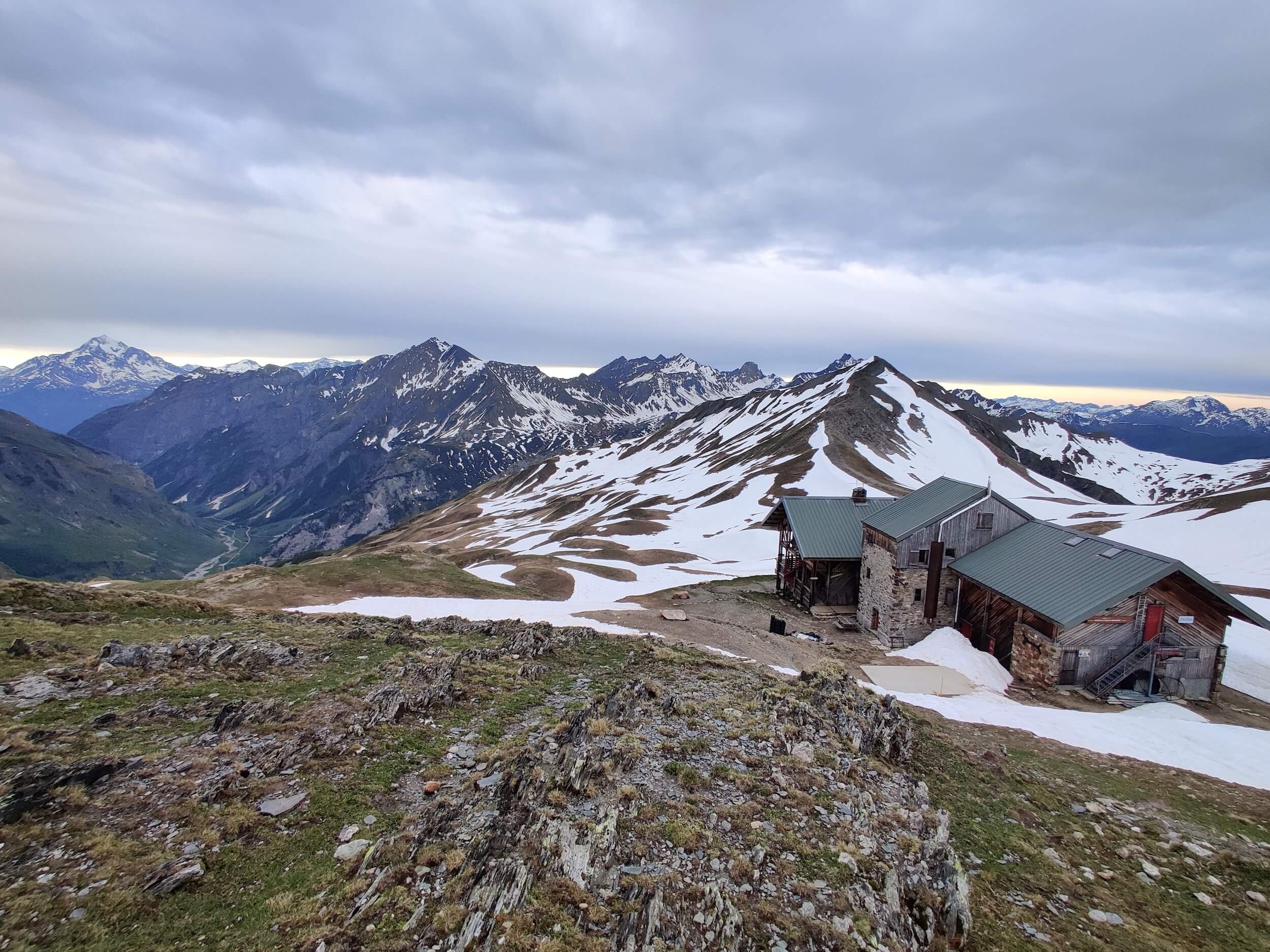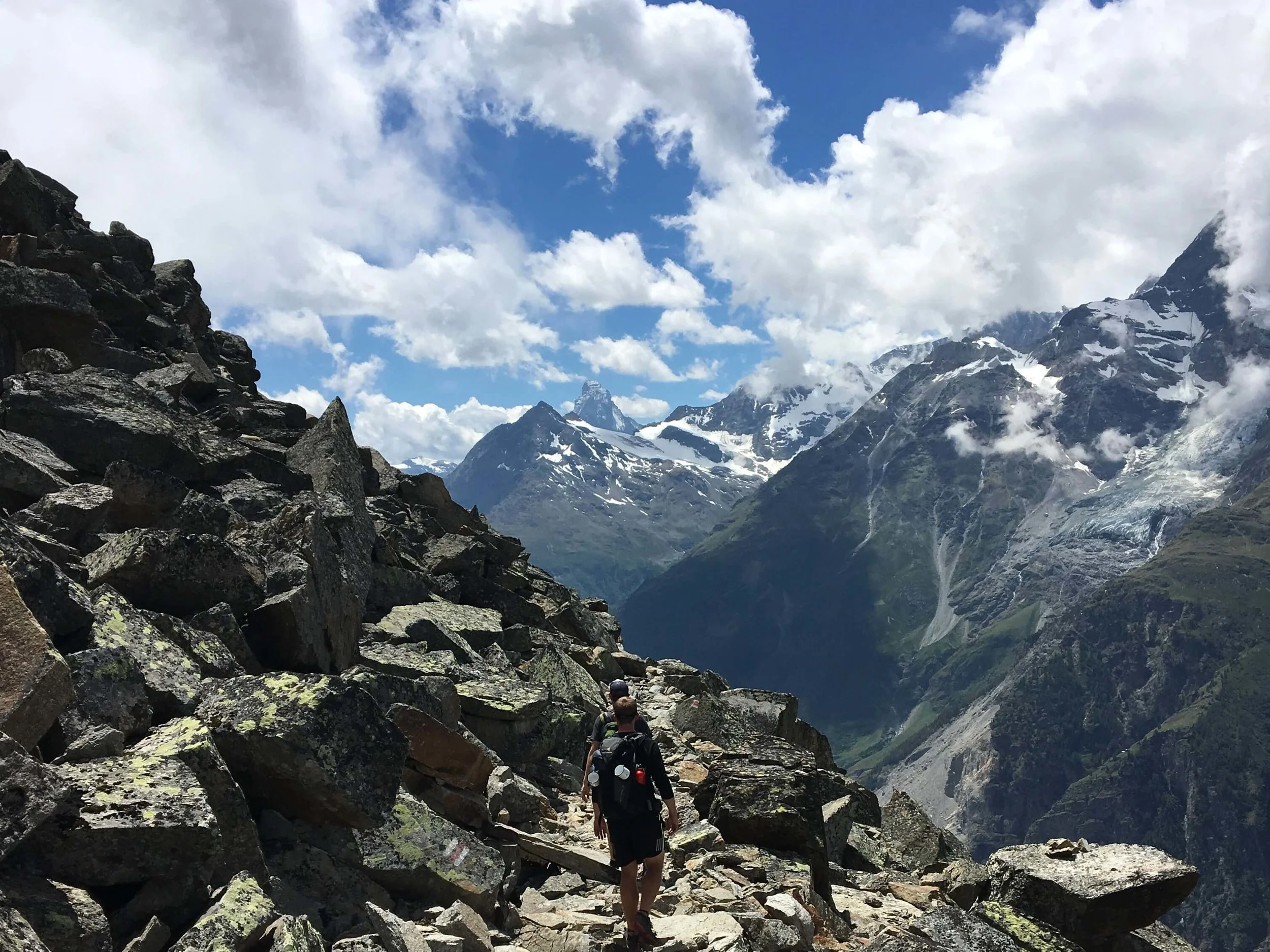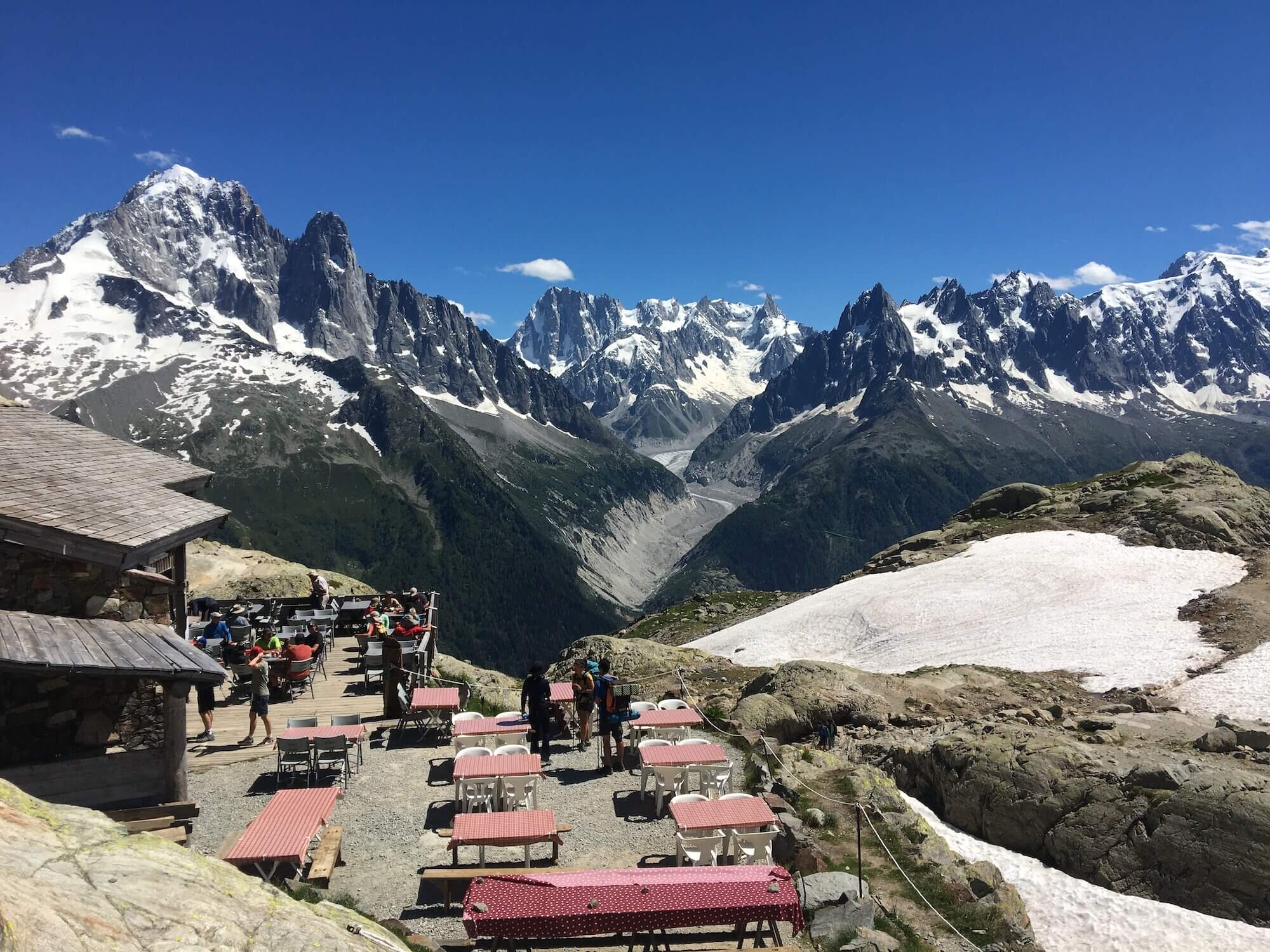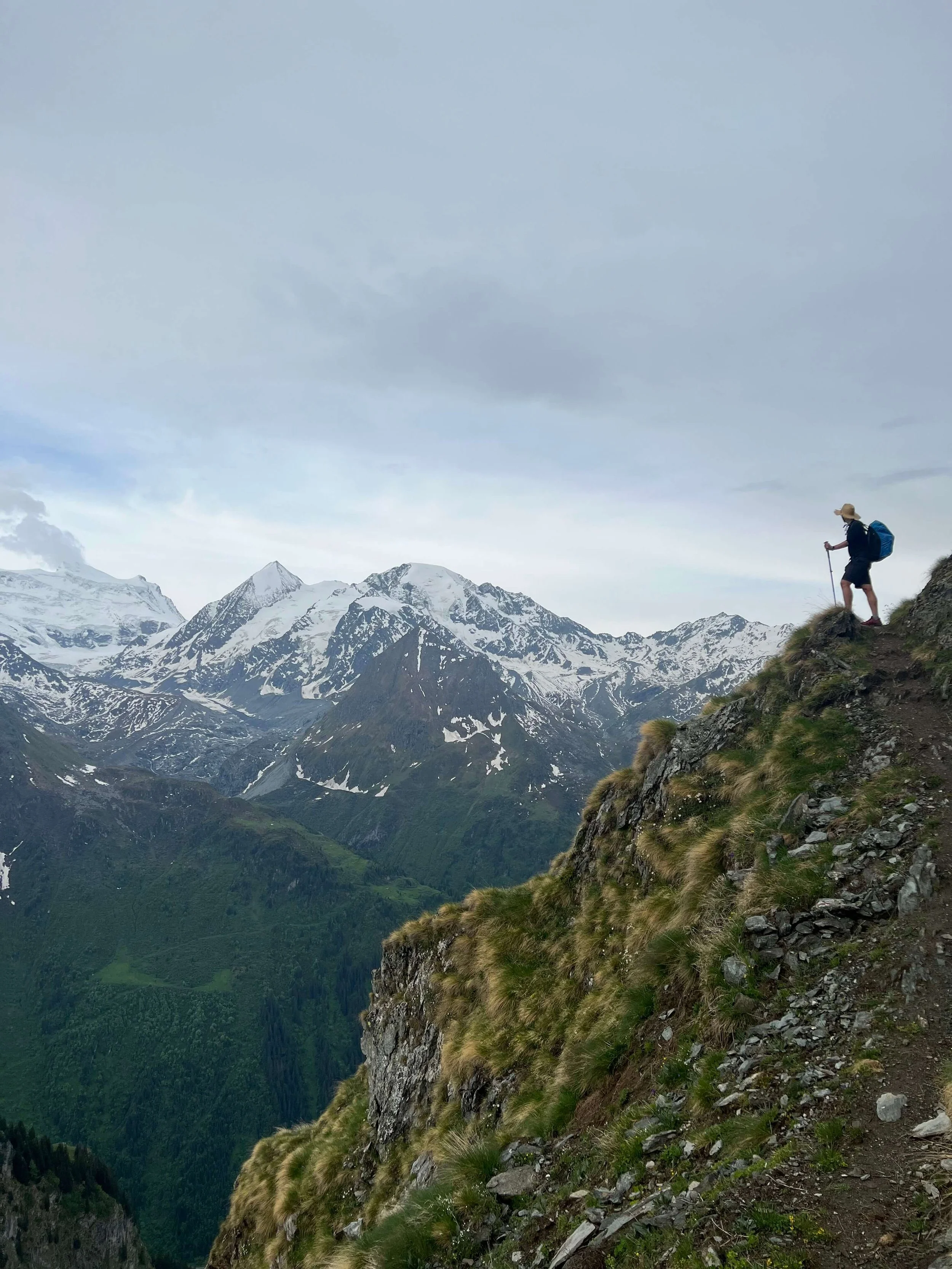Learn how my approach to training for the Alps has changed over the last 5 years and how Stacey from Pique to Peak has designed a session to help hikers create their own plan.
2025 Training Diary: Preparing for the hiking season
This summer, The Hiking Club team will be completing over 1,200km / 750mi to hike the top 8 multi-day hikes in Europe. We’ll be doing this as part of our 2025 Trail Updates program, as well as launching new hikes onto The Hiking Club platform. Sounds exciting, right? But, if I’m honest, also a little daunting. When it’s not hiking season in the Alps, I live at sea level and don’t have mountains on my doorstep. Not the best environment to get my body mountain fit!
Like previous years, I will be using our 3-month training plan that was developed in collaboration with Stacey Hardin, Doctor of Physical Therapy, and Athletic Trainer. This training plan helps people like me, build the endurance and strength to complete a multi-day hike in the Alps.
The aim of this training diary is to keep me accountable, share my progress and hopefully motivate you to start or continue training for your next epic hiking journey
If you’re interested which legendary hikes we’ll be doing, they are: Tour du Mont Blanc, Alta Via 1 Dolomites, Walker’s Haute Route, Tour des Combins, Bernese Oberland Traverse, Tour of Monte Rosa, West Highland Way, and a few we’ll keep on the downlow :P
susan’s WEEK 1: creating my training plan
(Monday 12th March > Sunday 16th March)
The first hike that I’ll be tackling in June is the Alta Via 1 in the Dolomites. The trail is 120km / 75mi, 7,400m / 24,00ft in elevation gain, and I’m aiming to complete it in 5 days.
One of the first pieces of information the training template needs to calculate how long it will take me to prepare for this trail distance is my current weekly step count. Luckily, I wear my Apple Watch everyday so I can easily check last week’s count - 77,000 steps.
Based on the above information, it shows it will take me 13 weeks to work my step count to the hike distance of 120km / 75 mi. (See how the right column turns green at week 13 when my step gap to readiness goal is met). With my trip 12 weeks out, I need to get cracking to ensure I’m ready!
Based on last week’s step count and the trail stats for Alta Via 1 Dolomites, the training plan shows it will take me 13 weeks to build up the endurance to complete the trail in 5 days.
The next step is creating my week 1 training plan. This week is a little bit different from normal as I got a Peleton bike for my birthday (yes - best husband ever!) so I’ll start to incorporate indoor cycling into my weekly schedule.
My focus for the first 4 weeks is ramping up key elements:
Increasing to 3 x strength sessions per week, by the end of the month
Plan: Use the training videos as part of the 3 month training program and start with 1 session in week 1, increase to 2 sessions for week 2 and 3, end with 3 sessions in week 4. I will tune into how my body feels as I activate new muscle groups and adjust accordingly.
Add one big steps day per week, increasing by 10% per week
Plan: Schedule short hike / trail run on Friday mornings, starting with 1 hour.
Continue 4+ short cardio sessions per week
Plan: Mixing up running, swimming and cycling
Gradually increasing total weekly step count (+5% per week, to minimise chance of injury)
Plan: Last month average was 77,000 steps per week. Aim to increase to 90,000 steps by week 4.
Here’s what my week 1 plan looks like:
My week 1 training plan using the training template from the 3 Month Training Program.
I’ll report back on progress over the next few weeks. Wish me luck!
2024 Training Diary: First 6 weeks
Off season activities: I enjoyed competing in a local triathlon during the off-season. Michael (L) and Brendan (R).
In October each year, I transition to my hiking off-season exercise regime, which involves very little forward planning, structure, or activity tracking. This is in stark contrast to my action-packed hiking season in the Alps, which is all about detailed daily planning and capturing content. While my off-season approach to exercise usually adds a couple of inches to the waistline, it’s a great way to unwind and give my body a break.
At the end of February, my approach to exercise changes gear as I move from free-wheeling to a formal training plan in preparation for the upcoming hiking season in the Alps! I started following a structured plan in the lead-up to last season and found it to be a game-changer given my old approach was no longer working for me. You can read more about my training environment and change in approach here.
As noted in our first training diary blog post, Susan and I are planning to complete 8 legendary hikes to share updates for our existing trails and capture content for new trails we’ll be adding to The Hiking Club platform. My training plan for this year has been designed around completing the Tour du Mont Blanc in 5 days. All the trails I do after this will have similar size days, so provided I stay healthy and focus on recovery and maintaining my fitness between hikes, this is the right plan for me.
Training plans for hiking in the Alps: The Hiking Club has an educational webinar and template to help hikers create their own training plan.
I created my own training plan by using our template last year to prepare for my ‘Break the Trail’ hike. Given I was able to achieve all my hiking goals in 2023, I’m using our training program again for my 2024 preparation! Below, you will find a few notes and a self-determined grade for each of the training components over the first 6 weeks of my 2024 training plan.
Starting point
I chose to immediately build on my average weekly step count from the weeks leading up to the start of my training program rather than reducing my step starting point by taking credit for introducing strength sessions. I felt confident doing this wouldn’t overload my training, as I had already taken a conservative estimate on my current weekly step count and was already doing a lot of cardio training, which would be reduced. By using this approach, based on my average weekly steps before starting the program, our training framework calculated that I needed a 12-week training plan to reach the goal of being ready for a 5-day Tour du Mont Blanc.
Strength sessions
Mark: 5/10
Despite having the best intentions to complete these, I’ve only done half of the sessions so far. Because of this, I haven’t done any ‘deload’ weeks as I’m already having these rests by not doing all the sessions. I’m disappointed by this, given I know how important and beneficial they are! I always plan to do them in the evening after the kids have gone to bed. However, I’m not very motivated to exercise at this time, especially when it’s the second workout of the day, so I needed to change it up for the next 6 weeks!
ENDURANCE TRAINING - SHORT CARDIO
Mark: 10/10
Bike riding: I love understanding how to take credit for different activities with the conversion table in our training plan. Pat (L) and Brendan (R)
I’m enjoying a variety of activities for my short cardio, including swimming, running, stair-stepping machines, and bike riding. I haven’t had any problems achieving my short cardio goal, and I regularly go well over the weekly target, given that it’s normal for me to do a lot of cardio each week.
ENDURANCE TRAINING - STEPS
Mark: 8/10
Training in Australia: A steps endurance session quickly turns into a short cardio session when there is a snake on the trail!
I’ve had a lot of variability in my step count each week. In total, I’ve done 33,000 more steps than I needed to over the first 6 weeks of the program, however, I’ve gone way over the weekly goal in half the weeks and then between 2,000-7,500 steps under on the other half. Each week, I’m pleased to have completed a longer endurance session on Saturday and will focus on trying to get closer to the step goal each week.
One thing I realised is that my stride length is nearly 50% higher when I run than when I walk. Therefore, I’m doing a distance-based step conversion for any hiking/running where my stride length is more than a walk, so they can be applied to the overall step count in the same step unit measurement (which is my average step/stride walking length).
REST
Mark: 8/10
One planned rest day and occasionally I’ve also had another unplanned day when I couldn’t find the time for training. Rather than changing my plan to train on my next planned rest day, I’ve opted to ‘catch up’ on the endurance training.
It’s great to be back training with purpose again. Based on how I’m feeling halfway through my 3-month program, I’m confident that I’ll have the endurance and strength to thrive on my 2024 Break The Trail hike. If you want to use our training program to create your own plan, check out the bundle below.
Author: Brendan Jones, The Hiking Club
A pizza-making, craft beer-loving, peanut butter connoisseur that has been exploring the great outdoors since completing the Duke of Edinburgh Award in high school. He started The Hiking Club to democratise hiking and the benefits that come from spending time in nature. You can read more about Brendan and the team here.
How to sustain energy on a multi-day hike
Hiking Poles: Essential Gear for Long-Distance Hiking in the Alps
Hiking poles are essential gear for long-distance hiking in the Alps. They provide a number of physical benefits that can help you hike more comfortably and efficiently. Read our blog post to learn more about why to use hiking poles, how to use them, where to buy them and how to travel with them on the aeroplane.
The Complete Guide to Foot Blister Management for Hikers, Walkers and Trekkers
Prepare your body for hiking in the Alps
Stacey Hardin is a hiker, Doctor of Physical Therapy, and athletic trainer that grew up with the Pacific Crest Trail in her backyard. Stacey’s experience on the Tour du Mont Blanc confirmed that there are a huge number of preventable injuries that impact bucket list hiking trips each year.
In this guest blog post, Stacey breaks down the factors that cause injuries on the trail and introduces a few simple exercises that can address one of them to start preparing your body for hiking in the Alps.
Yoga and hiking: when two worlds entwine
Yoga is an ancient practice dating back some 5,000 years or more, but it’s not as old as the act of walking.
Studies have shown that hiking offers some parallel benefits to yoga bringing you not only physical but also mental well-being benefits.
The great thing about yoga is it offers total body conditioning, incorporating strength work, aerobic exercise, flexibility training and stretching. Like hiking, yoga brings you into the present moment and can be part of a soul-full practice.
The importance of maintaining a strong and flexible body for improved physical fitness while hiking in the mountains goes without saying. But many of us take it for granted that we need to keep our bodies in good condition to help us enjoy the sports we do and love.
After a day of hiking, you might develop some soreness and niggles in your body. More specifically in the back, shoulders, legs, hips, knees, ankles and feet.
Hiking in the mountains for several days or weeks at a time, carrying a heavy pack, camping or sleeping in unfamiliar beds, can take its toll on your body. Completing a fitness regime and training for your trip will ensure you are physically ready. But maintaining your body while you are hiking is just as important.
So why include yoga as part of your training regime for a hiking trip?
(and continue your practice on the trail)
Yoga helps to improve your balance, which reduces your chance of getting injured while hiking over varied terrain
Doing yoga strengthens your core muscles, which are important for your hiking endurance
Yoga promotes strength and mobility and will enable you to move more efficiently through the mountains and expend less energy
Yoga will reduce tightness in the key areas affected by hiking, that being the hips, hamstrings and lower back
Regular yoga practice will maintain loose muscles, and allow you a full range of motion
Yoga helps you feel more mentally balanced and helps you to relax, and that in turn brings physical health benefits
The beauty of yoga is that you can do it almost anywhere. To learn proper technique, like any new exercise you should seek out a qualified yoga instructor. Yoga is something you can do at the start of your day to warm up or at the end of the day as a reset. Yoga will maintain your body so you can continue to hike for longer with less risk of injury and reducing fatigue.
So how does yoga help you in other ways with your hiking experience?
Breathing is the most important thing you do; aside from keeping us alive, it is a way we connect to one another and all living creatures on the planet. It goes without saying that breathing techniques in yoga – pranayama (prana – vital life force; yama – to control), bring concentration to your practice and allow you to tune into your body.
These same techniques can be used during your hiking adventures, to center yourself and bring you into the moment, but also to help you get up those steep alpine climbs.
A slow and steady breath should be practiced while doing yoga and whilst hiking, and by learning to control your breath you will in turn keep your hiking at a steady manageable pace and bring yourself into the present moment.
A regular yoga practice will bring you a greater awareness of your bodily proprioception and control. Yoga builds your form, developing your strength, flexibility and balance. It can help reduce bodily pain and can calm the mind and reduce stress. By practicing a regular yoga routine, you will see the benefits throughout your life including when you hike the mountain trails.
Yoga teaches you to listen to your breath and to your body
You will be able to tune into the small signs that something may need attention when you are out hiking, and you will be able to rest up before you potentially do damage that could take some time to heal.
By practicing yoga, you will more easily be able to bring yourself into the moment.
As a result, when you are hiking you become more present in the experience of nature, and you will be aware of your surroundings and appreciate the very moment you are in.
What are you waiting for? Invest some time today in a new yoga practice, a mental and physical practice that will bring benefits to your hiking form and to the rest of your life.
Author: Alistair Crompton, France
Alistair is a hiking and running guide, and a yoga teacher based in the Chamonix Valley in the French Alps. After using yoga to help train for the Sydney marathon in 2014 he decided to qualify as a yoga teacher and since moving to the Alps, his love for trail running in Chamonix has led him to train as an international mountain leader, where he now combines his love of hiking, running and yoga. He is now trying to figure out how to combine his passion for paragliding!
All photography by Alistair Crompton.
WHO ARE WE?
The Hiking Club empowers anyone to walk the way they want in the wild with personalised self-guided hiking experiences that are easy to find, quick to plan and simple to navigate.
We believe hiking experiences have the power to transform lives. With a growing range of personalised hikes that take into account your preferences, fitness and interests, we give you everything you need to explore the legendary trails of the world!
